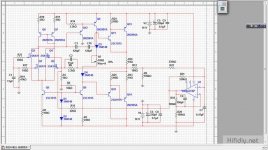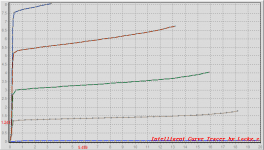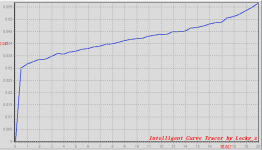Germanium transistors can be easily found in radio receivers made about 30 years ago. From the first stage through to the last stage, it could be all powered by those tiny tined naughties. Though vulnerable to high voltage and temperature change and notorious for high leakage, they played important role in those old days to transit music into each household, even in remote areas, just like the broadband Internet today.
Their sound is very distinctive from those of silicon solid states, much looser and smoother. Somebody says silicon solid state may suffer from unstable frequency characteristics when being overdriven, while Germaniums will not, just like a tube. That somewhat makes sense (you will know it by listening to the recorded replay posted hereinafter). But Germaniums are usually having poor characteristic frequency and it would be hard to find something beyond 10MHz, partially for at that time the communication system didn’t need too high frequency like today and partially for the era of Germaniums ended too early and too soon.
However, things always have exceptions. Fortunately China has been long embracing Germaniums till late 1990s and for this reason it ever produced Germanium transistors with characteristic frequency up to 4GHz. And those with 100MHz, something typical with an audio silicon solid state, were mass manufactured and can easily be found even today over online stores. And what is more amazing is that they can have high Hfe (relatively to those primitive ones), such as 100 to 200 or even higher and low leakage, such as when Vce=10V, the leakage is smaller than 50uA. This opens an opportunity to build a DC-coupled Germanium-Silicon hybrid preamp with Germaniums used as voltage amplification and output devices, with slew-rate better than conventional Ops, such as AD797 and LME49710/720.
How to handle the low CE voltage ability of Germaniums took me some time to think, and finally I decided to use a Douglas type topology in which the voltage amplification device only needs to bear a single rail’s voltage, for example 10V as I used in this case. The push-pull architecture can contribute another merit by cancelling the Germanium’s leakage noise, yielding better noise performance than those traditional single-ended architectures. What is different to Douglas is that I replaced the first input bipolar pair with a pair of JFETs and removed the coupling electrolytic capacitor on the feedback path to enable real DC-coupling. For output, to save the efforts to calibrate for zero DC output and to protect downstream solid-state power amplifier, I used film output capacitors to block DC output.
Their sound is very distinctive from those of silicon solid states, much looser and smoother. Somebody says silicon solid state may suffer from unstable frequency characteristics when being overdriven, while Germaniums will not, just like a tube. That somewhat makes sense (you will know it by listening to the recorded replay posted hereinafter). But Germaniums are usually having poor characteristic frequency and it would be hard to find something beyond 10MHz, partially for at that time the communication system didn’t need too high frequency like today and partially for the era of Germaniums ended too early and too soon.
However, things always have exceptions. Fortunately China has been long embracing Germaniums till late 1990s and for this reason it ever produced Germanium transistors with characteristic frequency up to 4GHz. And those with 100MHz, something typical with an audio silicon solid state, were mass manufactured and can easily be found even today over online stores. And what is more amazing is that they can have high Hfe (relatively to those primitive ones), such as 100 to 200 or even higher and low leakage, such as when Vce=10V, the leakage is smaller than 50uA. This opens an opportunity to build a DC-coupled Germanium-Silicon hybrid preamp with Germaniums used as voltage amplification and output devices, with slew-rate better than conventional Ops, such as AD797 and LME49710/720.
How to handle the low CE voltage ability of Germaniums took me some time to think, and finally I decided to use a Douglas type topology in which the voltage amplification device only needs to bear a single rail’s voltage, for example 10V as I used in this case. The push-pull architecture can contribute another merit by cancelling the Germanium’s leakage noise, yielding better noise performance than those traditional single-ended architectures. What is different to Douglas is that I replaced the first input bipolar pair with a pair of JFETs and removed the coupling electrolytic capacitor on the feedback path to enable real DC-coupling. For output, to save the efforts to calibrate for zero DC output and to protect downstream solid-state power amplifier, I used film output capacitors to block DC output.
Last edited:
Some Pics of the real thing.
The real thing:
http://pic.hifidiy.net/forum/201505/29/214820z58s2hj8hhq25a0t.jpg
Lower frequency response:
http://pic.hifidiy.net/forum/201505/29/214828c0btopbqzgft3eim.jpg
Higher frequency response:
http://pic.hifidiy.net/forum/201505/29/214834iirrelrps6ufhdxf.jpg
Wanna know its sound? Pls click this link:
http://pan.baidu.com/s/1dDEUhwd
And for the Album, actually Bach's violin concerto:
http://pic.hifidiy.net/forum/201506/07/084244pntoqzu4ob82bn7n.jpg
The real thing:
http://pic.hifidiy.net/forum/201505/29/214820z58s2hj8hhq25a0t.jpg
Lower frequency response:
http://pic.hifidiy.net/forum/201505/29/214828c0btopbqzgft3eim.jpg
Higher frequency response:
http://pic.hifidiy.net/forum/201505/29/214834iirrelrps6ufhdxf.jpg
Wanna know its sound? Pls click this link:
http://pan.baidu.com/s/1dDEUhwd
And for the Album, actually Bach's violin concerto:
http://pic.hifidiy.net/forum/201506/07/084244pntoqzu4ob82bn7n.jpg
So Kenneth are you going to show us your schematic and where we can buy these amazing transistors?
The leakage noise of the voltage amplification stage will be fed into the push-pull output stage in reverse phase. This is likely to cancell it. A differential pair can do this, too, for such noise can be deemed as common mode noise, if the pair is truly paired. But it would be harder to construct a germanium differential pair for practical use, due to their limited CE voltage ability, i.e. the curve of transistor on either arm of the pair will be materially different when they're working under different CE voltage.
Anyway the annoying higher frequency noise of convential germanium amplifier disappears. I've not tested the noise floor, but I can hear deadly silence when I put my ear close to the tweeter.
The schematic is just a slight modification from a Douglas Class A amp, with modifications already introduced above.
And for sourcing, you may check online component stores on Taobao or Alibaba, if you've ever heard of it.
I remember a british audiophine website once posted a thread talking about a guitar amp user found plentiful supply of Germanium transistors from China and these transistors made him very satisfied.
Anyway the annoying higher frequency noise of convential germanium amplifier disappears. I've not tested the noise floor, but I can hear deadly silence when I put my ear close to the tweeter.
The schematic is just a slight modification from a Douglas Class A amp, with modifications already introduced above.
And for sourcing, you may check online component stores on Taobao or Alibaba, if you've ever heard of it.
I remember a british audiophine website once posted a thread talking about a guitar amp user found plentiful supply of Germanium transistors from China and these transistors made him very satisfied.
I used to use XB113 pnp germanium back in 1966. They had an Hfe of about 12 when wired as a pnp and about 3 when wired up as an npn!
Absolute rubbish compared with today's silicon types.
I seem to remember they make good white noise generators.
Sony, Sanyo and Toshiba still use OA type germanium diodes, they must have loads left over from the 50's.
Absolute rubbish compared with today's silicon types.
I seem to remember they make good white noise generators.
Sony, Sanyo and Toshiba still use OA type germanium diodes, they must have loads left over from the 50's.
Noise is random. You can't cancel a random signal by adding another random signal.
Using Ge transistors nowadays is making a 'virtue' out of (what was) necessity.
Using Ge transistors nowadays is making a 'virtue' out of (what was) necessity.
BTW, have you downloaded the recorded music and listen to it? It sounds nice, I think.
In fact, I choose Germanium transistor for a trial just to use its low impedance. At proper working point (CE voltage and quiescent current combination), the internal impedance could be as low as several kiloohms (like a triode tube). Think of a voltage amplification stage loaded with a CCS that can have gain up to 10K times but its output impedance is within several kiloohms.
In fact, I choose Germanium transistor for a trial just to use its low impedance. At proper working point (CE voltage and quiescent current combination), the internal impedance could be as low as several kiloohms (like a triode tube). Think of a voltage amplification stage loaded with a CCS that can have gain up to 10K times but its output impedance is within several kiloohms.
Noise is random. You can't cancel a random signal by adding another random signal.
Using Ge transistors nowadays is making a 'virtue' out of (what was) necessity.
Actually there're several kinds of noises that will be generated by transistors, and in nature they are all random.
But leakage noise is particularly challenging for Germaniums, as they have very large leakage in comparison with silicons. A signal Germanium may have a leakage as large as or even larger than that of a power silicon. So it must be addressed with care to avoid hearable white noise. By the way, a power stage constructed with power silicons in push-pull topology, despite their much larger leakage than signal silicons when they are working in high heat, such as Class A, they can still have good S/N performance.
Go back to the subject. Of course the leakage noise is random. But at a given time point, so long as it can be split into reverse phases with same amplitude, at the output point, there will be very small level of it left, as they would be cancelled, just like the water waves of the same amplitude but in reverse phases running in a water tank.
"... so long as it can be split into reverse phases with same amplitude..."
So how do you separate the noise from the audio signal, which will also be subtracted to zero in your scheme!?
So how do you separate the noise from the audio signal, which will also be subtracted to zero in your scheme!?
Noise, I personally can't stand any hum in an audio gear, not even if barely audible, but if You intend by noise a faintly zzzzzzzz it is not bad at all, it adds some charm to the music, I was never bothered by that..😛
"... so long as it can be split into reverse phases with same amplitude..."
So how do you separate the noise from the audio signal, which will also be subtracted to zero in your scheme!?
This is a good question. I think the splitting is not a spin-off. Perhaps I've not made it clear enough.
Firstly, I've tested the preamp with earphones (32ohm highly sensitive ones for portable gears) and I actually hear no hiss at all.
Secondly, the mechanism, in my understanding, is a little bit like the plate-cathode phase splitting in a tube amplifier (splitting). We know a tube push-pull amplifer can be much more immune to 50Hz noise caused by using AC to heat filiaments than a SE can do. There's no need to substract, retrieve or separate the noise signal from the usable audio signal. It will be cancelled after the phase splittling or reversing when being fed into the push-pull stage.
Last edited:
Member
Joined 2009
Paid Member
I think its interesting to explore a different technology, perhaps in spite of the engineering challenges. I think Mooly has a nice Ge headphone amp and there is a Russian member who has good things to say about Power Ge devices in his own experiments.
- Home
- Amplifiers
- Solid State
- Miraculous Germanium Transistors from China


